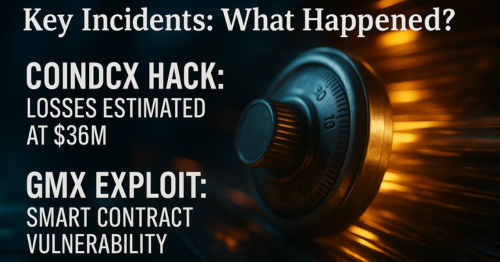Introduction: A Dangerous Month for Crypto Security
July 2025 proved to be one of the most devastating months for the cryptocurrency sector in terms of security breaches. In total, over $142 million was stolen across 17 separate crypto hacks, marking a sharp rise in both the number and scale of attacks compared to the previous months. Major platforms like CoinDCX and GMX were at the center of the damage, highlighting significant vulnerabilities in both centralized and decentralized finance systems.
As the crypto industry pushes toward wider adoption, these recurring attacks raise serious questions about the state of blockchain security and the ability of platforms to safeguard user assets.
The Numbers: Breaking Down the $142 Million Loss
A Grim July for Web3
According to blockchain forensics and security trackers, a staggering $142 million was lost through various attack vectors, including smart contract exploits, private key leaks, flash loan attacks, and wallet breaches. July’s total represents a 38% increase compared to the previous month, indicating a growing threat landscape.
High-Profile Platforms Under Siege
Among the hardest-hit were CoinDCX, a major Indian exchange, and GMX, a decentralized perpetual trading platform. Combined, they accounted for nearly $56 million of the total losses. Other platforms affected include several DeFi protocols and NFT marketplaces, underscoring the systemic nature of the vulnerabilities.
Key Incidents: What Happened?

CoinDCX Hack: Losses Estimated at $36M
The CoinDCX breach involved unauthorized access to the exchange’s hot wallet infrastructure. Preliminary investigations suggest compromised API keys and poor operational security as root causes. Although withdrawals have been paused, recovery remains uncertain, and law enforcement is reportedly involved.
GMX Exploit: Smart Contract Vulnerability
In the case of GMX, the attacker exploited a loophole in the price oracle mechanism, allowing them to manipulate asset prices in their favor. The exploit resulted in a direct loss of $20 million, sparking a fresh debate about the limitations of oracle-dependent smart contracts.
Common Attack Vectors Used in July
Security analysts have identified the following recurring techniques used by attackers:
- Smart Contract Bugs: Outdated or poorly audited code continues to be exploited
- Phishing and Social Engineering: Admin credentials and seed phrases are increasingly targeted
- Flash Loan Exploits: Instant loan mechanisms are being used to manipulate markets and drain liquidity
- Private Key Leaks: Often stemming from insider threats or misconfigured servers
Each incident reflects both technical and human-related security gaps, emphasizing the need for multilayered defenses.
The Bigger Picture: DeFi and Centralized Platforms Equally at Risk
While early attacks primarily targeted centralized exchanges, July’s incidents demonstrate that DeFi platforms are just as vulnerable, if not more so. The decentralized nature of DeFi makes real-time governance intervention difficult, giving attackers a wider window to execute malicious actions before responses are coordinated.
This month’s hacks reaffirm the urgent need for:
- Comprehensive Smart Contract audits
- Multi-signature wallet solutions
- Real-time monitoring and response systems
- Transparent incident disclosure policies
Regulatory and Industry Reactions
Following the events of July, there has been increased pressure on regulatory bodies to impose stricter cybersecurity mandates for crypto platforms. In India, the CoinDCX breach has reignited calls for centralized oversight of digital asset exchanges.
Meanwhile, several industry-leading security firms are stepping up to offer bug bounty programs, on-chain analytics, and risk scoring for smart contracts. However, adoption remains uneven across the ecosystem.
Investor Sentiment: Fear Resurfaces
The wave of hacks has triggered significant outflows from affected platforms, with users moving funds to wallets or more established exchanges perceived as safer. Google Trends data showed a 70% spike in searches for terms like “crypto platform hack” and “withdraw funds CoinDCX,” indicating widespread concern among retail investors.
Market confidence, particularly in emerging economies like India, is fragile. Rebuilding trust may require not just better security but also clear communication, user education, and transparency from platforms.
What Can Be Done: Best Practices for Users and Developers
For Users
- Use hardware wallets for long-term storage
- Enable 2FA and avoid public Wi-Fi when accessing wallets
- Be cautious of suspicious links and unsolicited messages
For Developers and Platforms
- Conduct frequent audits with reputable third-party firms
- Adopt formal verification tools for smart contracts
- Use upgradable contract frameworks to patch exploits quickly
- Implement layered authentication and monitor admin activities
Conclusion: The Road Ahead for Crypto Security
The $142 million stolen in July 2025 is more than a figure. It’s a reflection of the ongoing challenges that the crypto industry must urgently address. As platforms grow and Web3 becomes more mainstream, the need for robust, battle-tested security infrastructure is non-negotiable.
While hacks like those seen at CoinDCX and GMX are alarming, they also serve as painful reminders that security cannot be an afterthought. Until both centralized and decentralized ecosystems prioritize defense as rigorously as innovation, headlines like these will continue to repeat.
🔺 Top 3 Gainers (24h Performance)
1. SPK (SPK) – $0.119 (+30.21%)
SPK rebounded sharply after previously declining, as renewed developer activity and transparent updates reassured the community. The return of consistent project communications and speculative buying drove short-term gains.
2. MAGIC (MAGIC) – $0.203 (+24.51%)
MAGIC continued its upward trajectory thanks to growing excitement around the metaverse and NFT ecosystems. Strategic integrations with NFT marketplaces and a rise in play-to-earn game adoption helped bolster trading momentum.
3. ENA (ENA) – $0.632 (+13.85%)
ENA posted solid gains following the announcement of a new Layer-2 scaling initiative. Improved scalability and reduced transaction fees attracted DeFi users, leading to increased trading volume and investor interest.
🔻 Top 3 Losers (24h Performance)
1. BROCCOLI714 (BRO) – $0.047 (–5.63%)
BROCCOLI714 plummeted after reports of stalled roadmap execution and unclear utility sparked investor concern. The lack of ecosystem development updates led to heavy sell pressure and a drop in community trust.
2. GUN (GUN) – $0.027 (–2.27%)
GUN faced a sharp decline amid concerns over centralization and a recent wallet exploit rumor. The token’s price fell as users exited positions due to heightened risk and a slowdown in user engagement.
3. DIA (DIA) – $0.778 (–1.36%)
DIA slipped in performance as the broader oracles sector faced reduced demand. Despite ongoing partnerships, lower on-chain activity and waning interest from institutional users dragged down momentum.

I work as a content writer in the blockchain and cryptocurrency domain. I have a keen interest in exploring the world of digital assets, Web3, and emerging crypto technologies. My goal is to provide readers with easy-to-understand, engaging, and trustworthy insights, helping them stay informed and confident in the rapidly evolving world of crypto and blockchain.










